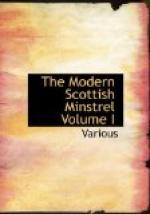In the “Pirate,” published in 1823, the author of “Waverley” had compared the condition of Minna to that of Jeanie Gray, in the words of Lady Anne, in a sequel which she had published to the original ballad:—
“Nae langer she wept,
her tears were a’ spent;
Despair it was come, and she
thought it content;
She thought it content, but
her cheek it grew pale,
And she droop’d like
a snowdrop broke down by the hail!”
At length, in her seventy-third year, and upwards of half a century after the period of its composition, the author voluntarily made avowal of the authorship of the ballad and its sequel. She wrote to Sir Walter Scott, with whom she was acquainted, requesting him to inform his personal friend, the author of “Waverley,” that she was indeed the author. She enclosed a copy to Sir Walter, written in her own hand; and, with her consent, in the course of the following year, he printed “Auld Robin Gray” as a contribution to the Bannatyne Club.
The second part has not acquired such decided popularity, and it has not often been published with it in former Collections. Of the fact of its inequality, the accomplished author was fully aware: she wrote it simply to gratify the desire of her venerable mother, who often wished to know how “the unlucky business of Jeanie and Jamie ended.” The Countess, it may be remarked, was much gratified by the popularity of the ballad; and though she seems, out of respect to her daughter’s feelings, to have retained the secret, she could not resist the frequent repetition of it to her friends.
In the character of Lady Anne Barnard, the defective point was a certain want of decision, which not only led to her declining many distinguished and advantageous offers for her hand, but tended, in some measure, to deprive her of posthumous fame. Illustrative of the latter fact, it has been recorded that, having entrusted to Sir Walter Scott a volume of lyrics, composed by herself and by others of the noble house of Lindsay, with permission to give it to the world, she withdrew her consent after the compositions had been printed in a quarto volume, and were just on the eve of being published. The copies of the work, which was entitled “Lays of the Lindsays,” appear to have been destroyed. One lyric only has been recovered, beginning, “Why tarries my love?” It is printed as the composition of Lady Anne Barnard, in a note appended to the latest edition of Johnson’s “Musical Museum,” by Mr C. K. Sharpe, who transcribed it from the Scots Magazine for May 1805. The popular song, “Logie o’ Buchan,” sometimes attributed to Lady Anne in the Collections, did not proceed from her pen, but was composed by George Halket, parochial schoolmaster of Rathen, in Aberdeenshire, about the middle of the last century.




